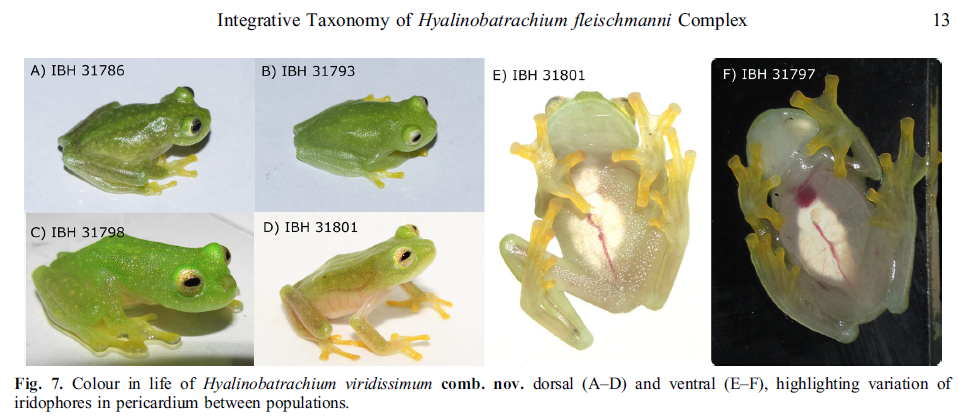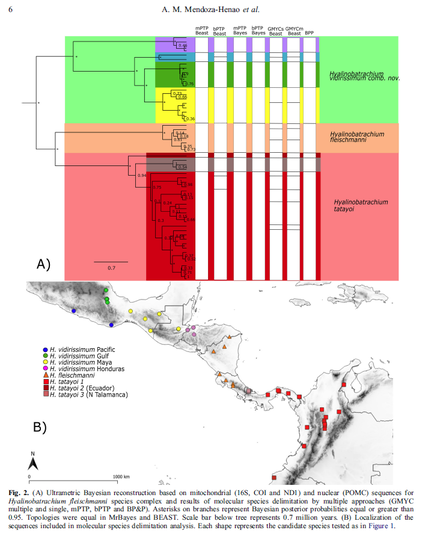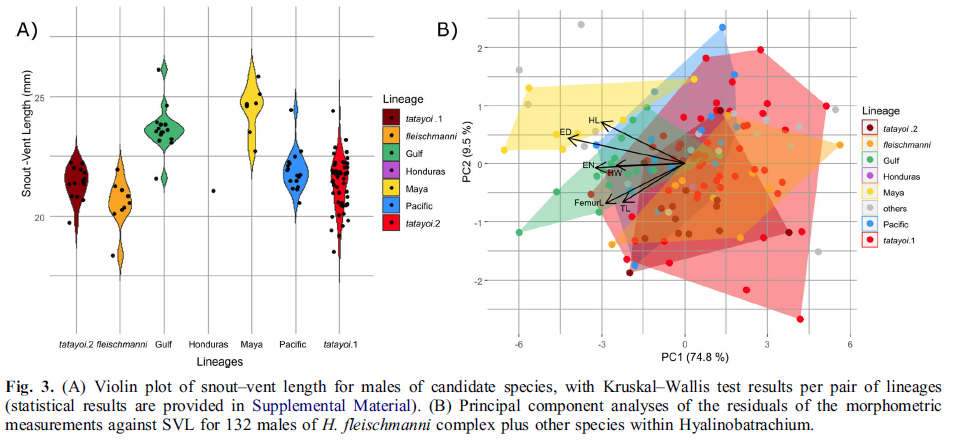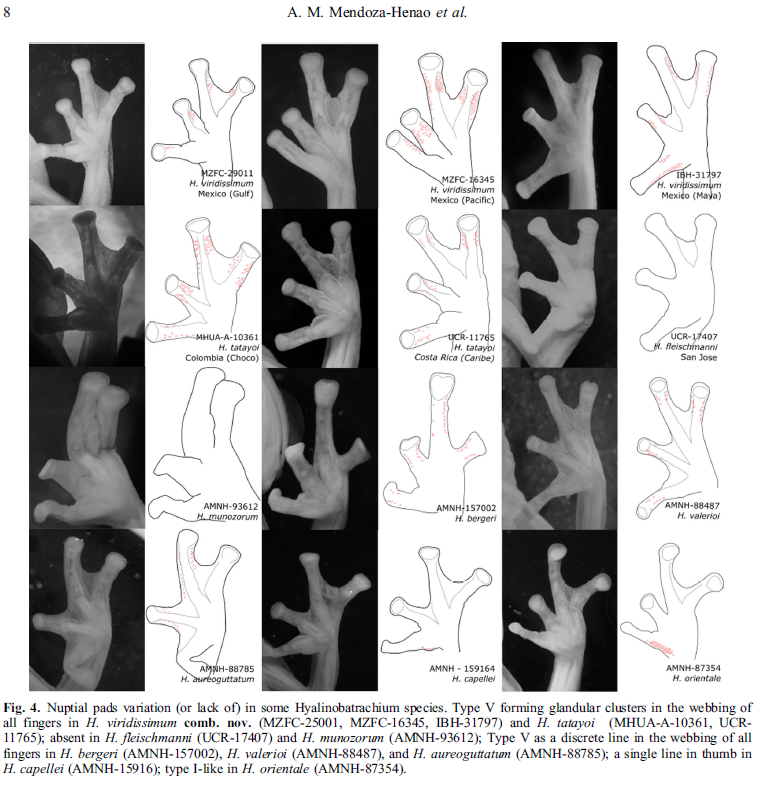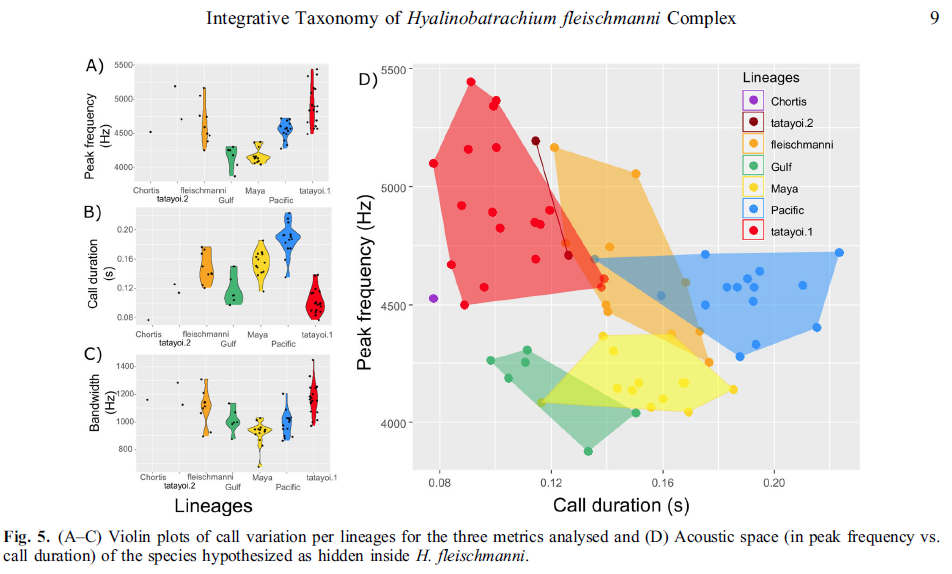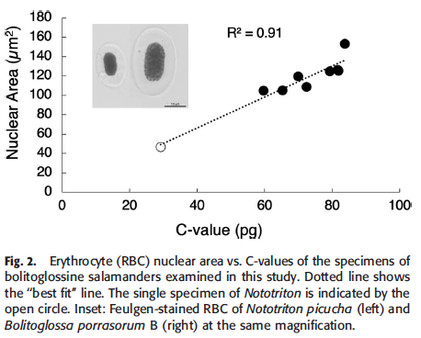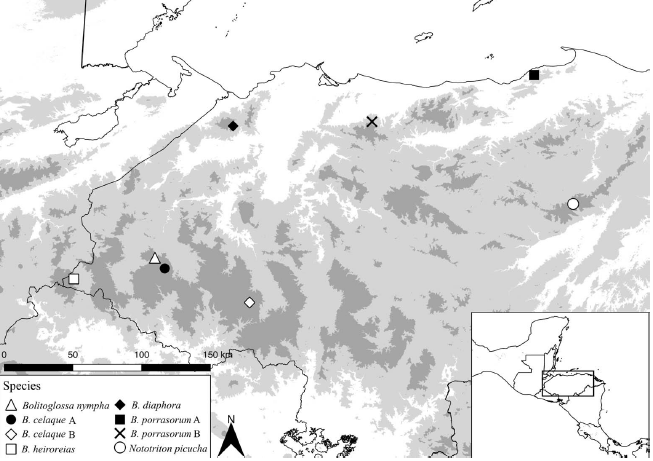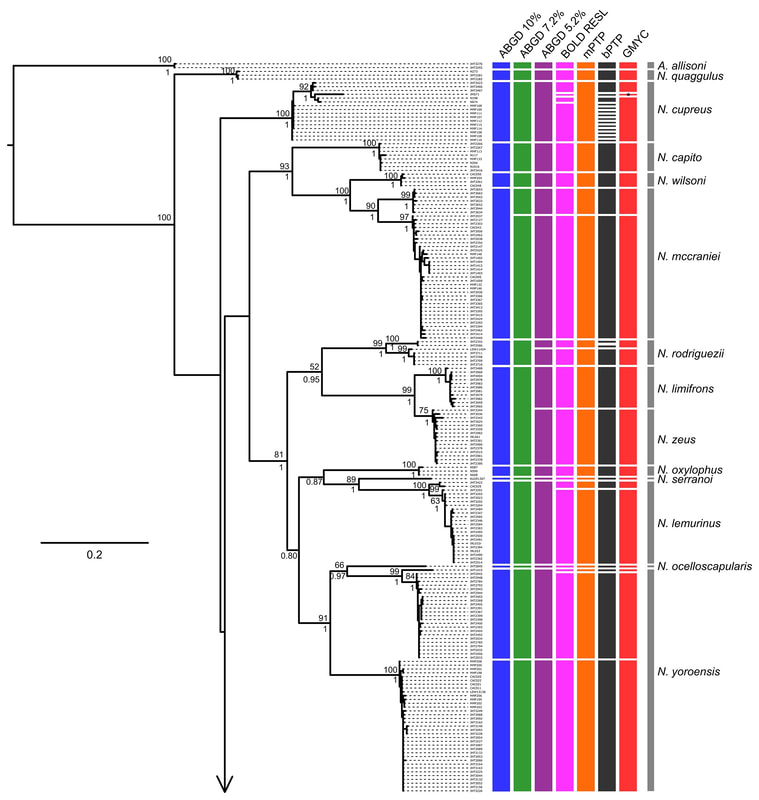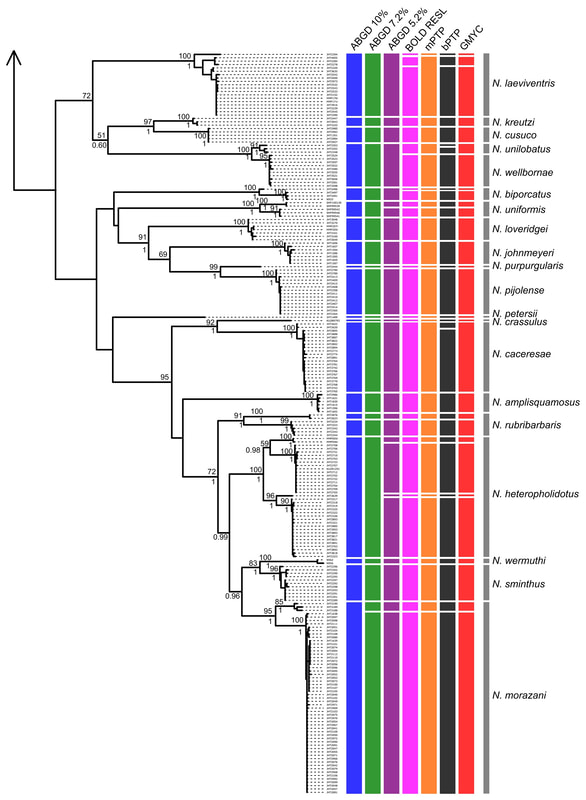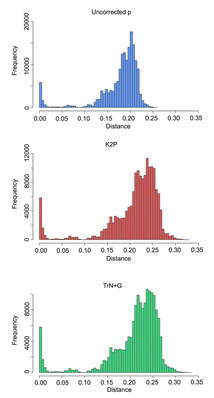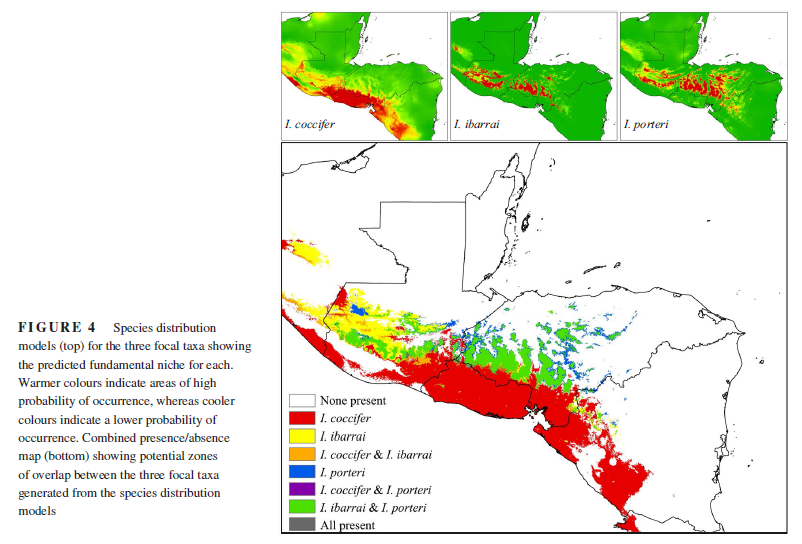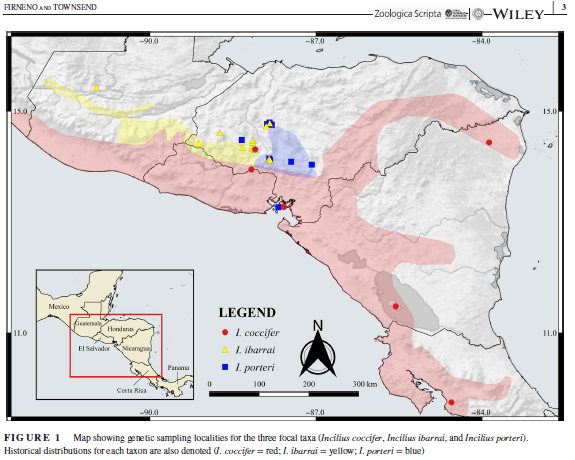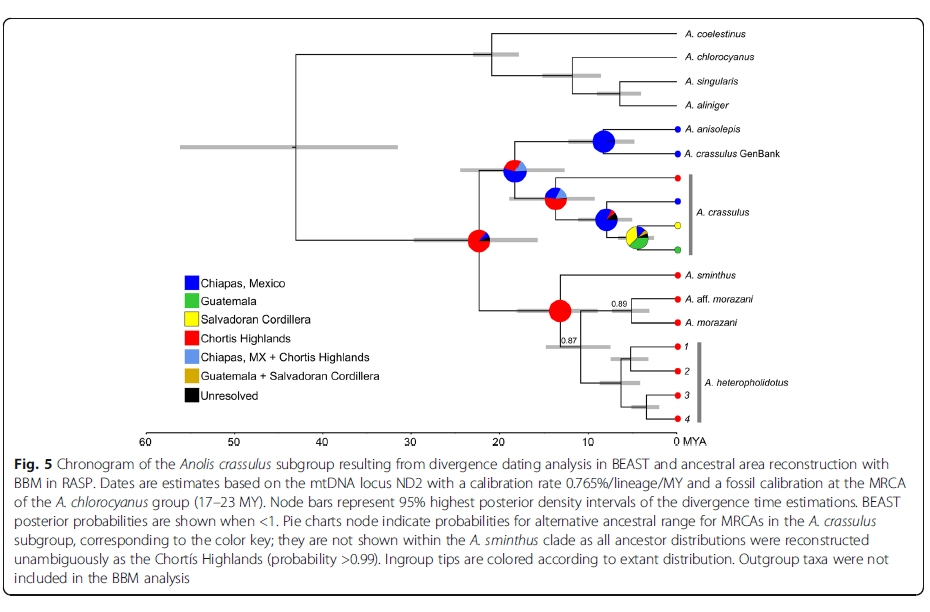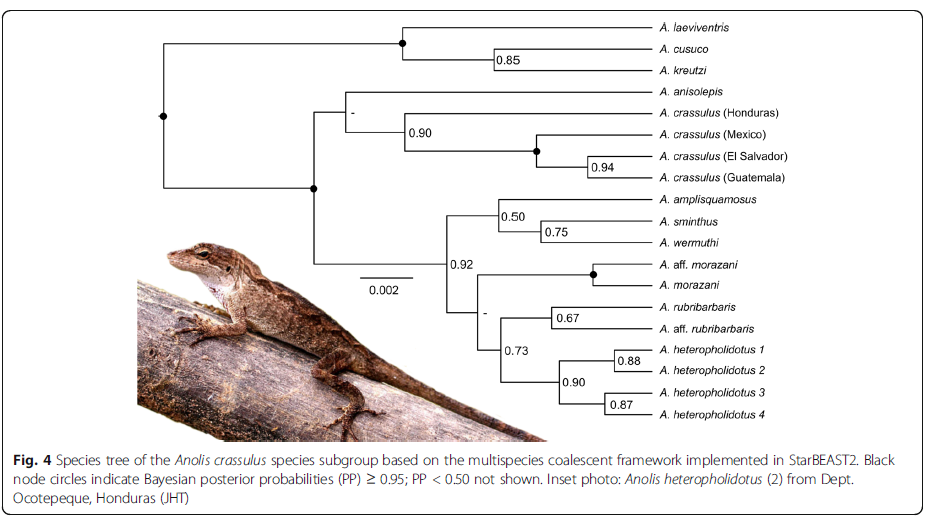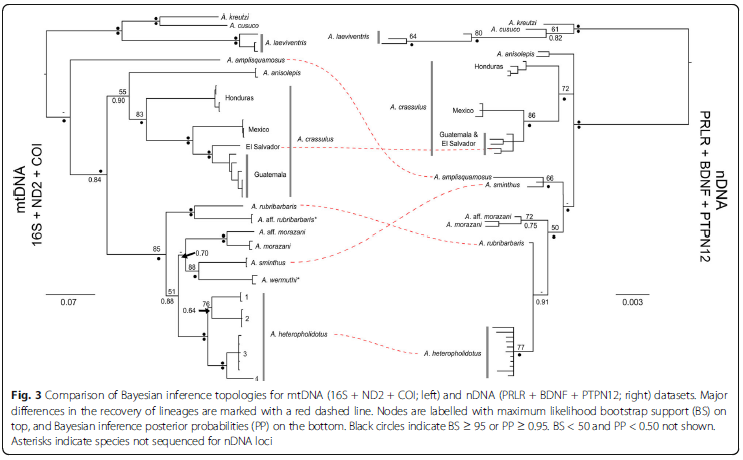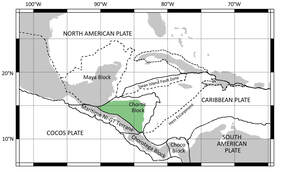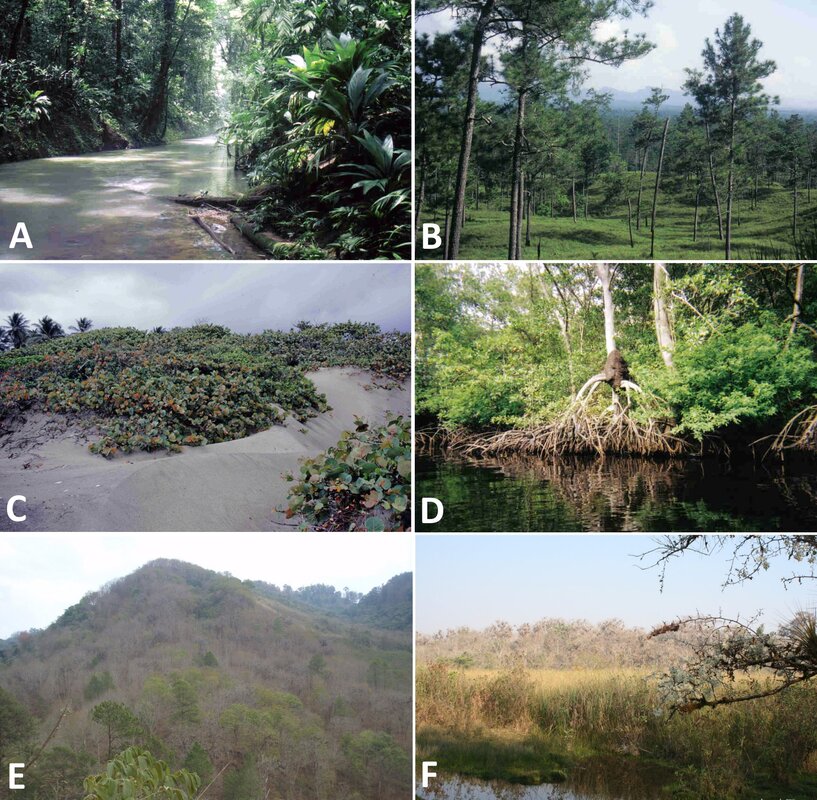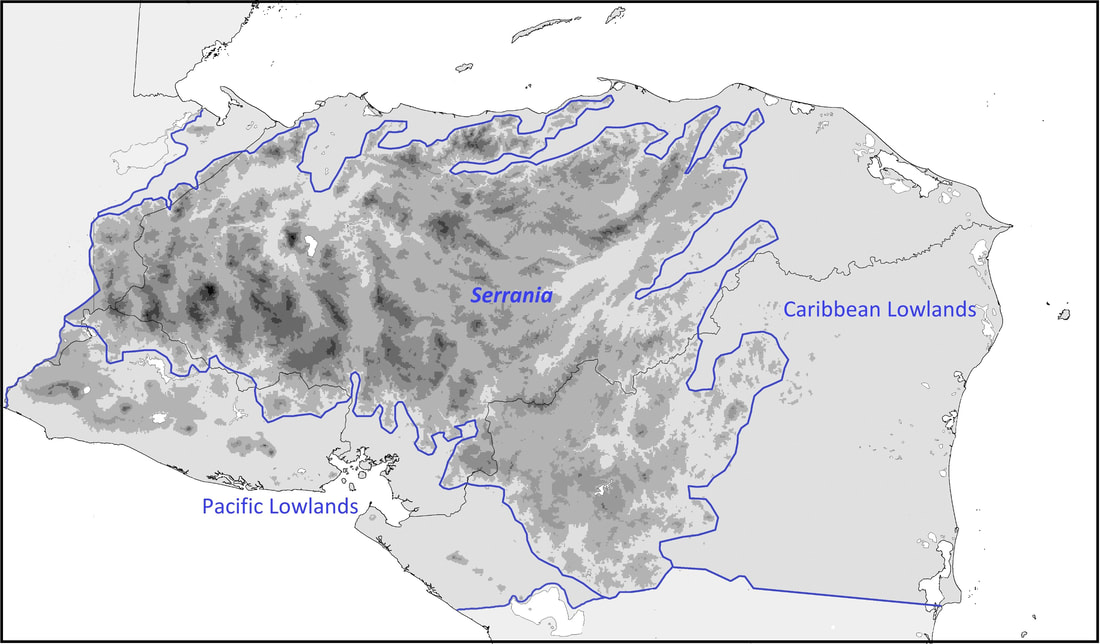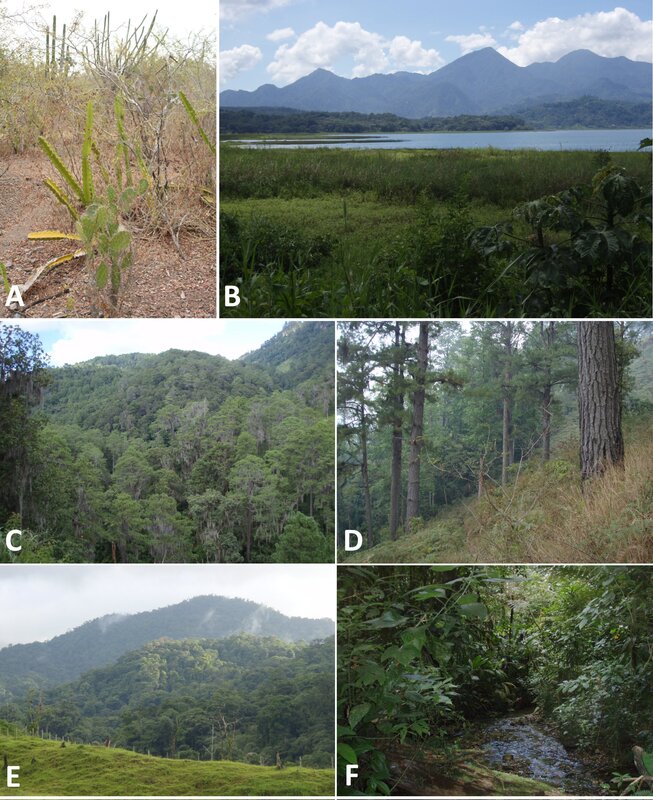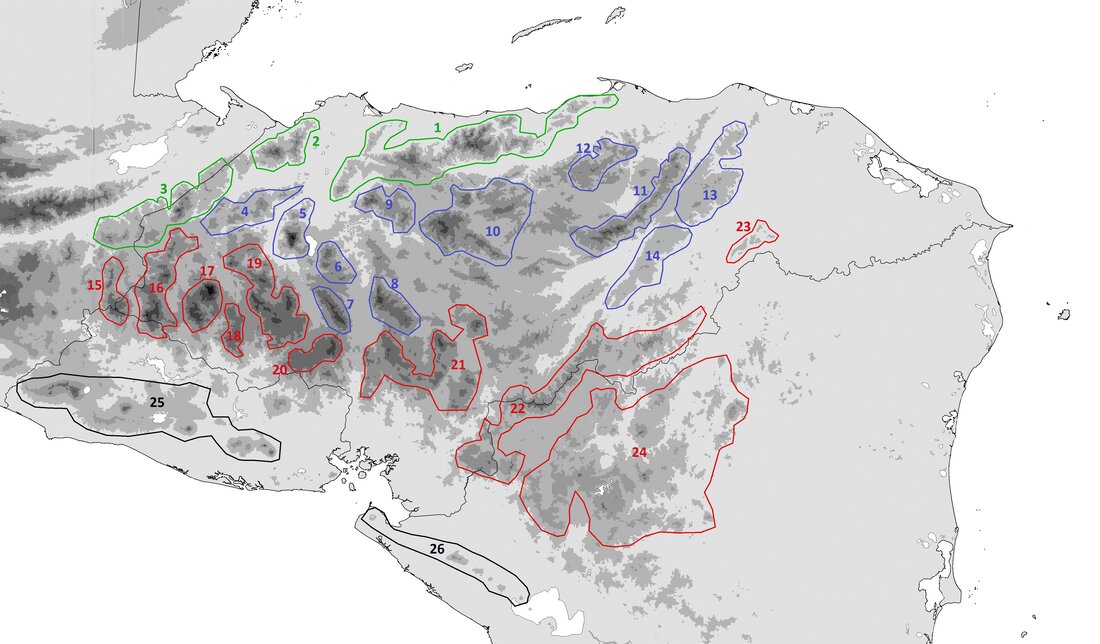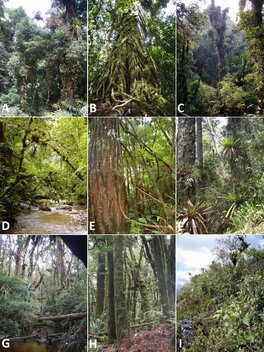Evolution, Diversification, & Biogeography of the
Chortis Herpetofauna
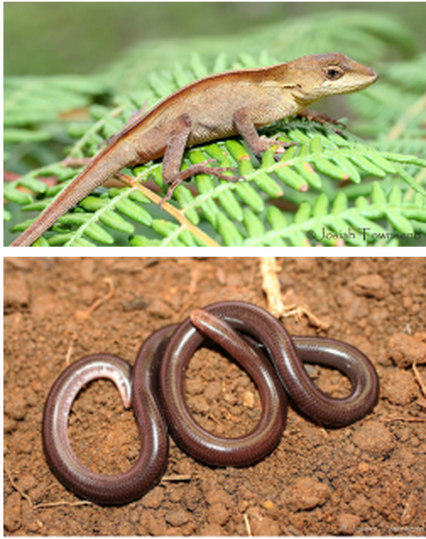
The Chortís Highlands have been shown to have a distinctive component of endemic biodiversity, particularly in amphibians and reptiles; however, molecular characterization of evolutionary diversification patterns in this region has been limited to a few studies of a restricted taxonomic breadth and broader geographic focus. This region has a challengingly complex geological history, and is located to the south and east of the tectonic boundary between the Chortís and Mayan Blocks and north of the Nicaraguan Depression, and are also referred to as Eastern Nuclear Central America.
The majority of the geographical extent of the Chortís Highlands is found within the political boundaries of Honduras, the country that is home to at least 103 endemic species with the highest degree of herpetofaunal endemism of any Central American nation. The majority of endemic species are restricted to one or a few isolated cloud forest localities, with many cloud forests supporting their own unique endemic communities of amphibians and reptiles.
While undertaking remote fieldwork in Mesoamerican cloud forests, it is not uncommon to stumble across previously unknown or overlooked taxa. These can include cryptozoic species, like Typhlops tycherus and Tantilla olympia, as well as somewhat more conspicuous taxa, like Anolis morazani.
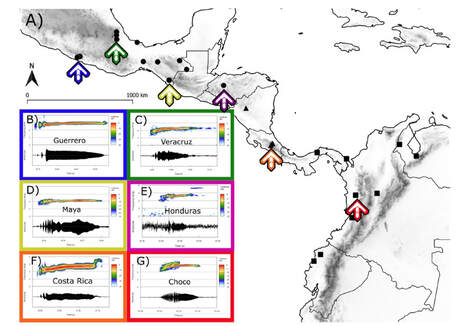
Phylogeny-based species delimitation and integrative taxonomic revision of the Hyalinobatrachium fleischmanni species complex, with resurrection of H. viridissimum (Taylor 1942)
Mendoza-Henao, AM, E Arias, JH Townsend, and G Parra-Olea. 2020.Systematics and Biodiversity 18(5): 464–484. Download here
A collaborative paper led by doctoral student (now PhD) Angy Mendoza from the lab of Dr. Gabriela Parra-Olea at the National Autonomous University of Mexico has provided a long-awaited revision of a widespread complex of cryptic glassfrogs hidden under the name Hyalinobatrachium fleischmanni. In the paper, published in the journal Systematics and Biodiversity, we present a comprehensive integrative assessment of multilocus phylogenetic relationships, comparative morphology, and bioacoustics, and we conclude to restrict the name H. fleischmanni to populations from eastern Honduras south through Nicaragua and Costa Rica, resurrecting the name H. viridissimum for northern populations, and assigning populations from eastern Costa Rica south through Panama to H. tatayoi.
The study also confirms that populations in the central-western Chortis Block previously referred to as H. fleischmanni may representative of an undescribed species, with a follow up study to assess morphological and bioacoustic variation of the Chortis population underway.
Mendoza-Henao, AM, E Arias, JH Townsend, and G Parra-Olea. 2020.Systematics and Biodiversity 18(5): 464–484. Download here
A collaborative paper led by doctoral student (now PhD) Angy Mendoza from the lab of Dr. Gabriela Parra-Olea at the National Autonomous University of Mexico has provided a long-awaited revision of a widespread complex of cryptic glassfrogs hidden under the name Hyalinobatrachium fleischmanni. In the paper, published in the journal Systematics and Biodiversity, we present a comprehensive integrative assessment of multilocus phylogenetic relationships, comparative morphology, and bioacoustics, and we conclude to restrict the name H. fleischmanni to populations from eastern Honduras south through Nicaragua and Costa Rica, resurrecting the name H. viridissimum for northern populations, and assigning populations from eastern Costa Rica south through Panama to H. tatayoi.
The study also confirms that populations in the central-western Chortis Block previously referred to as H. fleischmanni may representative of an undescribed species, with a follow up study to assess morphological and bioacoustic variation of the Chortis population underway.
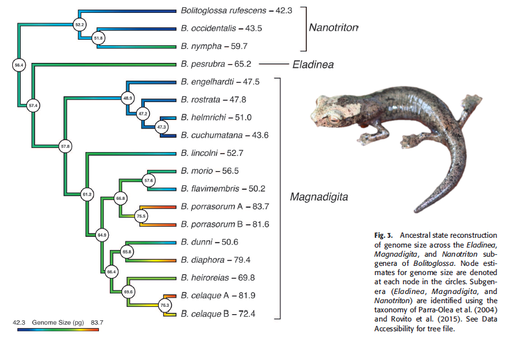
Genome size diversification in Central American bolitoglossine salamanders (Caudata; Plethodontidae)
Itgen, MW, P Prša, R Janža, L Skubic, JH Townsend, A Kladnik, L Bizjak Mali, and SK Sessions. 2019. Copeia 107(3): 560–566. Download here
In a recent paper published in Copeia, lab alum Mike Itgen presented results of a collaborative project examining the genome sizes in six species of Honduran salmanders. Some take-aways from the paper include:
- Genome sizes in Bolitoglossa range from 42-84 picograms, a 42-pg range that is equivalent to the size of about 14 human genomes
- Six mountain-top endemic species have genomes larger than any previously reported for the genus Bolitoglossa OR for the family Plenthodontidae
- Nototriton picucha, a single site endemic from eastern Honduras, has a moderate-sized genome relative to the rest of the family Plethodontidae
- Our evidence from two sister lineages (B. celaque A and B) suggest genome size increases can occur rapidly and independently from changes in sequence structure of functional genes
- Our evidence from Bolitoglossa (Nanotriton) nympha supports the presence of enucleated RBCs as a synapomorphy for the miniaturized subgenus Nanotriton
Itgen, MW, P Prša, R Janža, L Skubic, JH Townsend, A Kladnik, L Bizjak Mali, and SK Sessions. 2019. Copeia 107(3): 560–566. Download here
In a recent paper published in Copeia, lab alum Mike Itgen presented results of a collaborative project examining the genome sizes in six species of Honduran salmanders. Some take-aways from the paper include:
- Genome sizes in Bolitoglossa range from 42-84 picograms, a 42-pg range that is equivalent to the size of about 14 human genomes
- Six mountain-top endemic species have genomes larger than any previously reported for the genus Bolitoglossa OR for the family Plenthodontidae
- Nototriton picucha, a single site endemic from eastern Honduras, has a moderate-sized genome relative to the rest of the family Plethodontidae
- Our evidence from two sister lineages (B. celaque A and B) suggest genome size increases can occur rapidly and independently from changes in sequence structure of functional genes
- Our evidence from Bolitoglossa (Nanotriton) nympha supports the presence of enucleated RBCs as a synapomorphy for the miniaturized subgenus Nanotriton
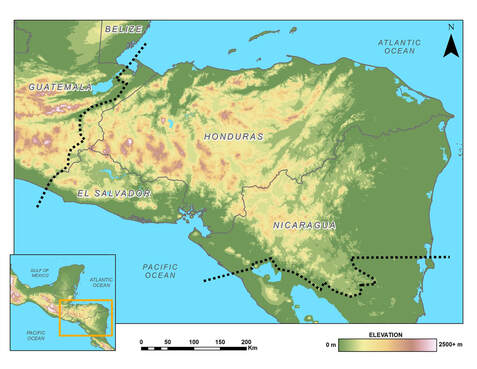
Cryptic diversity, but to what extent? Discordance between single-locus species delimitation methods within mainland anoles (Squamata: Dactyloidae) from Northern Central America
Hofmann, EP, KE Nicholson, IR Luque-Montes, G Köhler, C Cerrato-Mendoza, M Medina-Flores, LD Wilson, and JH Townsend. 2019. Frontiers in Genetics 10: 11 (1–13). Download here
In the third major paper from his MS thesis work, Erich Hofmann led a comprehensive examination of species-level diversity among Chortis Block anoles using a comparative set of DNA barcode-based species delimitation methods, which we recently published in the journal Frontiers In Genetics. In this paper, we explore diversity of mainland species of anole lizards from the Chortís Block biogeographical province of northern Central America using a DNA barcoding approach, generating and analyzing cytochrome oxidase subunit I (COI) sequences for over 400 samples assignable to 33 of 38 (86.8%) native and one introduced mainland species. We subsequently tested the effects different models of nucleotide substitution, different species-delimitation algorithms, and reducing our dataset had on species delimitation estimates. We used two distance-based (ABGD, RESL) and three tree-based (bPTP, mPTP, GMYC) analyses on both the full dataset and a dataset consisting only of unique halotypes.
From 34 nominal taxa, analyses of the full dataset recovered between 34 and 64 operational taxonomic units (OTUs), while analyses of the reduced dataset inferred between 36 and 59. Reassigning individuals to either mPTP-inferred or ABGD clustered (7.2% threshold) groups improved the detection of a barcoding gap across three different models of nucleotide substitution, removing overlap between intra- and interspecific distances. Our results highlight the underestimated diversity of mainland Chortís Block anoles, but the lack of congruence between analyses demonstrates the importance of considering multiple analytical methods when dealing with single-locus datasets. We recommend future studies consider the effects of different models of nucleotide substitution on proposed barcoding gaps, as well as the effect reducing a dataset to unique haplotypes may have on proposed diversity estimates.
Hofmann, EP, KE Nicholson, IR Luque-Montes, G Köhler, C Cerrato-Mendoza, M Medina-Flores, LD Wilson, and JH Townsend. 2019. Frontiers in Genetics 10: 11 (1–13). Download here
In the third major paper from his MS thesis work, Erich Hofmann led a comprehensive examination of species-level diversity among Chortis Block anoles using a comparative set of DNA barcode-based species delimitation methods, which we recently published in the journal Frontiers In Genetics. In this paper, we explore diversity of mainland species of anole lizards from the Chortís Block biogeographical province of northern Central America using a DNA barcoding approach, generating and analyzing cytochrome oxidase subunit I (COI) sequences for over 400 samples assignable to 33 of 38 (86.8%) native and one introduced mainland species. We subsequently tested the effects different models of nucleotide substitution, different species-delimitation algorithms, and reducing our dataset had on species delimitation estimates. We used two distance-based (ABGD, RESL) and three tree-based (bPTP, mPTP, GMYC) analyses on both the full dataset and a dataset consisting only of unique halotypes.
From 34 nominal taxa, analyses of the full dataset recovered between 34 and 64 operational taxonomic units (OTUs), while analyses of the reduced dataset inferred between 36 and 59. Reassigning individuals to either mPTP-inferred or ABGD clustered (7.2% threshold) groups improved the detection of a barcoding gap across three different models of nucleotide substitution, removing overlap between intra- and interspecific distances. Our results highlight the underestimated diversity of mainland Chortís Block anoles, but the lack of congruence between analyses demonstrates the importance of considering multiple analytical methods when dealing with single-locus datasets. We recommend future studies consider the effects of different models of nucleotide substitution on proposed barcoding gaps, as well as the effect reducing a dataset to unique haplotypes may have on proposed diversity estimates.
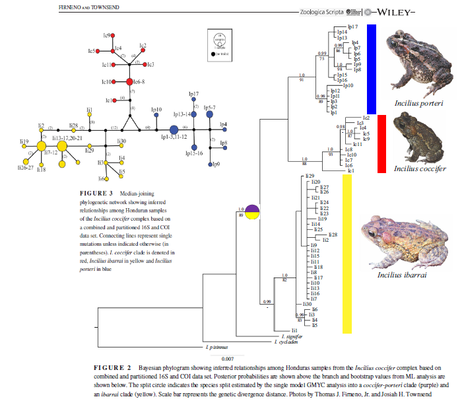
Integrative evaluation of species boundaries in sympatric and parapatric populations of Mesoamerican toads (Bufonidae: Incilius coccifer group)
Firneno, Jr., TJ, and JH Townsend. 2019. Zoologica Scripta 48(4): 454–465. Download here
The first comprehensive evaluation of a taxonomically-debated complex of Mesoamerican highland toads was published by Firneno and Townsend in a recent issue of the journal Zoologica Scripta. The Incilius coccifer complex in Honduras is comprised of three putative taxa: I. coccifer, I. ibarrai and I. porteri. The taxonomy of the I. coccifer complex has been a source of debate among specialists, with some recognizing three species, while others choose to recognize one widespread taxon. To assess species boundaries and evaluate the taxonomic structure for the I. coccifer complex, we utilized a combination of comprehensive field sampling, molecular phylogenetics and macroecological modelling. Using 58 samples representing all three putative taxa, we generated sequence data from the mitochondrial loci 16S and COI in order to assess genetic diversity and phylogenetic relationships, and tested putative species boundaries using General Mixed Yule‐Coalescent models. To evaluate macroecological differences in the distribution of putative taxa, we utilized maximum entropy modelling and identified areas of suitable and non‐suitable habitat, as well as identifying potential areas of overlap between species habitats. We recovered three clades that broadly correspond to the three named taxa that, while being monophyletic, are separated by relatively small genetic distances. Species distribution models revealed that I. coccifer is macroecologically different than the other two taxa, but that I. ibarrai and I. porteri are highly similar. We uncovered cases of sympatry between pairs of species in at least three localities in Honduras, suggesting the potential for hybridization in these closely related lineages.
Firneno, Jr., TJ, and JH Townsend. 2019. Zoologica Scripta 48(4): 454–465. Download here
The first comprehensive evaluation of a taxonomically-debated complex of Mesoamerican highland toads was published by Firneno and Townsend in a recent issue of the journal Zoologica Scripta. The Incilius coccifer complex in Honduras is comprised of three putative taxa: I. coccifer, I. ibarrai and I. porteri. The taxonomy of the I. coccifer complex has been a source of debate among specialists, with some recognizing three species, while others choose to recognize one widespread taxon. To assess species boundaries and evaluate the taxonomic structure for the I. coccifer complex, we utilized a combination of comprehensive field sampling, molecular phylogenetics and macroecological modelling. Using 58 samples representing all three putative taxa, we generated sequence data from the mitochondrial loci 16S and COI in order to assess genetic diversity and phylogenetic relationships, and tested putative species boundaries using General Mixed Yule‐Coalescent models. To evaluate macroecological differences in the distribution of putative taxa, we utilized maximum entropy modelling and identified areas of suitable and non‐suitable habitat, as well as identifying potential areas of overlap between species habitats. We recovered three clades that broadly correspond to the three named taxa that, while being monophyletic, are separated by relatively small genetic distances. Species distribution models revealed that I. coccifer is macroecologically different than the other two taxa, but that I. ibarrai and I. porteri are highly similar. We uncovered cases of sympatry between pairs of species in at least three localities in Honduras, suggesting the potential for hybridization in these closely related lineages.
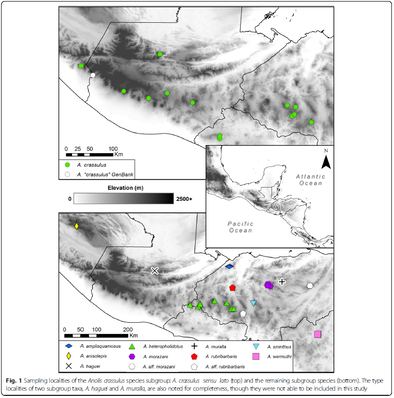
Origins and biogeography of the Anolis crassulus subgroup (Squamata: Dactyloidae) in the highlands of Nuclear Central America
Hofmann, EP, and JH Townsend. 2017. BMC Evolutionary Biology 17: 267. Download here
A portion of the thesis work completed by Townsend Lab alumni Erich Hofmann has been published in the journal BMC Evolutionary Biology, and is available for free download here: http://rdcu.be/C2pY. This paper brings some long-awaited clarity to the Anolis crassulus subgroup, a clade of lizards that has long frustrated taxonomists (see quotes below), and, among other things, reveals the following:
Hofmann, EP, and JH Townsend. 2017. BMC Evolutionary Biology 17: 267. Download here
A portion of the thesis work completed by Townsend Lab alumni Erich Hofmann has been published in the journal BMC Evolutionary Biology, and is available for free download here: http://rdcu.be/C2pY. This paper brings some long-awaited clarity to the Anolis crassulus subgroup, a clade of lizards that has long frustrated taxonomists (see quotes below), and, among other things, reveals the following:
- Populations of lizards called Anolis (Norops) crassulus from Intibuca, La Paz, and Lempira represent a new species.
- The Honduran lineage of Anolis crassulus diverged from other lineages approximately 13 million years ago.
- Cladogenesis in the A. crassulus subgroup began approximately 22 million years ago, with the common ancestor originating in the Chortis Block.
- Recognition of the species Anolis heteropholidotus, A. morazani, A. rubribarbaris, A. sminthus, and A. wermuthi is supported.
- Anolis heteropholidotus contains at least four allopatric mitochondrial lineages.
- Cryptic, allopatric lineages were uncovered that are sister lineages to A. morazani (in the Sierra de Agalta) and A. rubribarbaris (in the Guajiquiro region of La Paz).
- John R. Meyer & Larry D. Wilson (1971): “The inter-relationships of the populations… [of the crassulus group] are exceedingly complex, and… we are unable to suggest a satisfactory arrangement.”
- Carl S. Lieb (1981): “The resolution of the tremendous taxonomic problems raised by the schiedei [sic] species group, together with… the Anolis crassulus radiation is probably the most important single problem facing Anolis systematics.”
- James R. McCranie, Larry D. Wilson, & Kenneth L. Williams (1992): “Clearly, a thorough analysis of crassulus-like specimens from throughout their range from western Chiapas to northern El Salvador and southwestern Honduras is sorely needed.”
- James R. McCranie & Gunther Köhler (2015): “…a study of the N. crassulus-like populations with strongly keeled ventral scales from throughout their range from western Chiapas, Mexico, to northwestern El Salvador and southwestern and central Honduras is needed.”
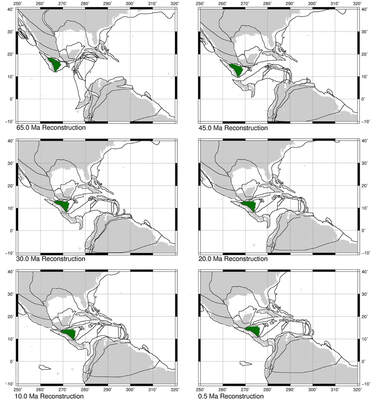
Characterizing the Chortís Block Biogeographic Province: geological, physiographic, and ecological associations and herpetofaunal diversity
Townsend, J. 2014. Mesoamerican Herpetology 1(2): 204–252.
Abstract: The geological history of Central America is remarkably complex, as the region has served as the biological dispersal route between North and South America, and also has been the site of extensive in situ evolution. Nuclear Central America is recognized as a region of high biodiversity, and the eastern portion of Nuclear Central America (the Chortís Block) largely has been overlooked as a biodiversity hotspot. In this paper, I present a characterization of geological, physiographic, and ecological associations to define the Chortís Block Biogeographic Province. The Chortís Block is partitioned into the Caribbean and Pacific Lowlands and the Northern, Central, and Southern cordilleras, which in turn are delimited into 24 distinct highland areas and 14 intermontane valleys. I provide contextualized definitions of ecological formations and identify six lowland-associated habitats, of which four habitats are shared between lowlands and highlands, and 10 habitats are associated with highlands areas. I present a summary of the diversity, distribution, and conservation status of the herpetofauna of the Chortís Block, using a combination of the published literature and results from 19 expeditions to over 60 localities from 2006 to 2014. The Chortís herpetofauna is characterized by a high degree of endemism (38% of all species are endemic) and equally high extinction risk (42% threatened, including 94% of endemic species). Endemism is highest among the salamanders (86%), followed by the lizards (43%), the anurans (38%), and the snakes (23%).
Townsend, J. 2014. Mesoamerican Herpetology 1(2): 204–252.
Abstract: The geological history of Central America is remarkably complex, as the region has served as the biological dispersal route between North and South America, and also has been the site of extensive in situ evolution. Nuclear Central America is recognized as a region of high biodiversity, and the eastern portion of Nuclear Central America (the Chortís Block) largely has been overlooked as a biodiversity hotspot. In this paper, I present a characterization of geological, physiographic, and ecological associations to define the Chortís Block Biogeographic Province. The Chortís Block is partitioned into the Caribbean and Pacific Lowlands and the Northern, Central, and Southern cordilleras, which in turn are delimited into 24 distinct highland areas and 14 intermontane valleys. I provide contextualized definitions of ecological formations and identify six lowland-associated habitats, of which four habitats are shared between lowlands and highlands, and 10 habitats are associated with highlands areas. I present a summary of the diversity, distribution, and conservation status of the herpetofauna of the Chortís Block, using a combination of the published literature and results from 19 expeditions to over 60 localities from 2006 to 2014. The Chortís herpetofauna is characterized by a high degree of endemism (38% of all species are endemic) and equally high extinction risk (42% threatened, including 94% of endemic species). Endemism is highest among the salamanders (86%), followed by the lizards (43%), the anurans (38%), and the snakes (23%).
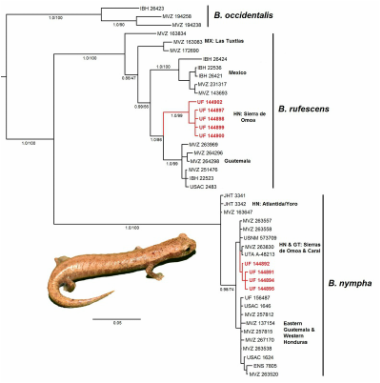
Microsympatry in cryptic lowland salamanders (Caudata: Plethodontidae: Bolitoglossa subgenus Nanotriton) from northwestern Honduras: implications for taxonomy and regional biogeography
Hess, AJ, MW Itgen, TJ Firneno, JC Nifong, and JH Townsend. 2016. Journal of Zoological Systematics and Evolutionary Research (Online Early): doi:10.1111/jzs.12151.
Abstract: The taxonomy of the diminutive bolitoglossine salamanders of the subgenus Nanotriton has previously been a source of confusion among specialists. At various times, at least three different species of Nanotriton have been reported to occur in Honduras: Bolitoglossa nympha, B. occidentalis, and B. rufescens. Phylogenetic analysis of 16S and cyt b from samples from three localities in Honduras (departments of Yoro, Copán, and Cortés) confirm that most populations are assignable to B. nympha. Nine samples collected from a single locality on the northern slope of the Sierra de Omoa, between 120–190 m in elevation, were found to represent two distinct taxa: B. nympha and B. rufescens. Field examination of these nine specimens found them to be morphologically indistinguishable, including a lack of maxillary teeth in all specimens. As such in situ identification of the two species in northwestern Honduras is problematic given the occurrence of the two taxa in microsympatry in at least one locality. The discovery of yet another divergent lineage of B. rufescens highlights the need for a taxonomic reassessment within this species complex.
Hess, AJ, MW Itgen, TJ Firneno, JC Nifong, and JH Townsend. 2016. Journal of Zoological Systematics and Evolutionary Research (Online Early): doi:10.1111/jzs.12151.
Abstract: The taxonomy of the diminutive bolitoglossine salamanders of the subgenus Nanotriton has previously been a source of confusion among specialists. At various times, at least three different species of Nanotriton have been reported to occur in Honduras: Bolitoglossa nympha, B. occidentalis, and B. rufescens. Phylogenetic analysis of 16S and cyt b from samples from three localities in Honduras (departments of Yoro, Copán, and Cortés) confirm that most populations are assignable to B. nympha. Nine samples collected from a single locality on the northern slope of the Sierra de Omoa, between 120–190 m in elevation, were found to represent two distinct taxa: B. nympha and B. rufescens. Field examination of these nine specimens found them to be morphologically indistinguishable, including a lack of maxillary teeth in all specimens. As such in situ identification of the two species in northwestern Honduras is problematic given the occurrence of the two taxa in microsympatry in at least one locality. The discovery of yet another divergent lineage of B. rufescens highlights the need for a taxonomic reassessment within this species complex.
